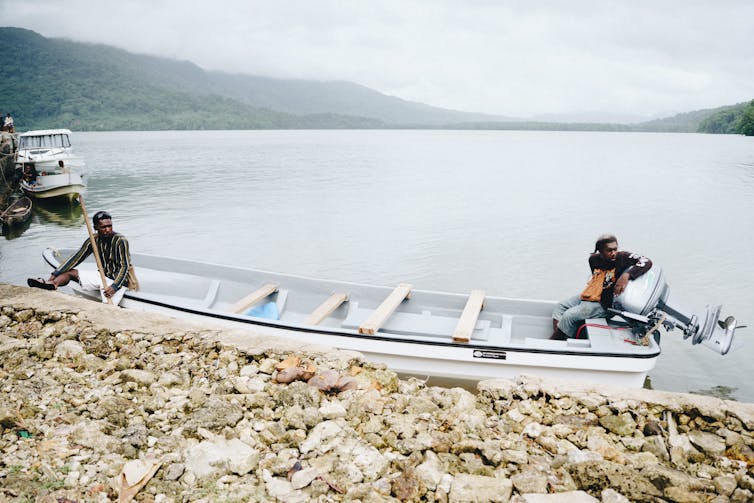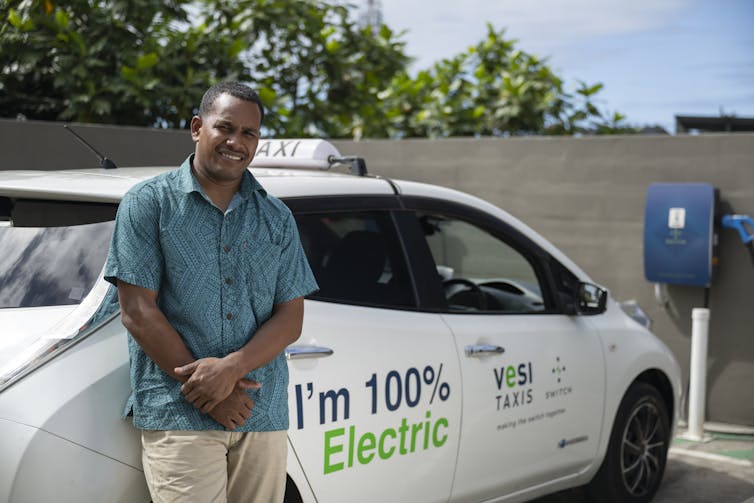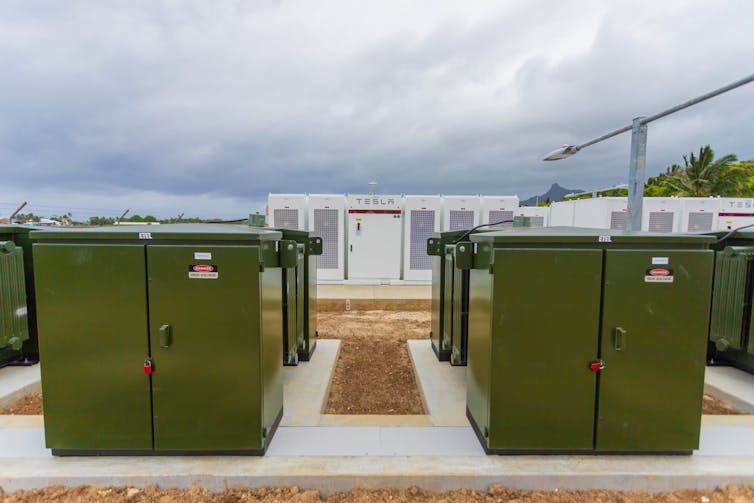How Pacific nations plan to go from spending up to 25% of GDP on fossil fuels to running on 100% renewables
- Written by Wesley Morgan, Research Associate, Institute for Climate Risk and Response, UNSW Sydney
Picture dusk falling somewhere in the Solomon Islands. A fisher’s skiff glides home using a whisper-quiet electric outboard motor. In the Cook Islands, a big battery steadies the island grid. In Papua New Guinea’s highlands, solar kits bring electric light to homes for the first time.
These aren’t prototypes – they’re already up and running across the Pacific. Put together, these stories of quiet change point to something bigger.
For decades, Pacific island countries have led the global fight on climate change. These nations are highly exposed to the damage from rising sea levels, acidifying oceans and bleached coral reefs. Pacific leaders helped secure the 2015 Paris Agreement and the global goal of holding warming to 1.5°C.
Now the Pacific is leading the way again. Island leaders have a bold plan to become the world’s first region powered entirely by renewables and energy storage.
The move isn’t symbolic. It’s extremely practical. Pacific nations spend an eye-watering percentage of their GDP (10–25%) buying fossil fuels to run power plants, generators and vehicles. Ending reliance on imports and becoming energy independent will bring major dividends. Despite widespread support, the Pacific’s clean energy transition has not yet taken off in earnest due to transport costs and gaps in financing, skills and regulation.
Leaders will formally release a renewable roadmap next week at the COP30 climate conference in Brazil. Pacific nations and Australia are bidding to host the next climate talks in 2026. Island leaders hope to leverage the global summit to attract investment in their own energy transition.

Slashing fossil fuel imports will save billions
Right now, Pacific countries spend A$9–14 billion a year importing diesel for generators and fuel for vehicles and boats.
Sharp falls in renewable costs mean solar and battery systems are now clearly cheaper than fossil fuels for electricity generation.
Even with the Pacific’s logistical challenges, installed costs for solar have fallen more than five-fold since 2010. The cost of grid-scale and home batteries is falling quickly.
Replacing diesel generation with solar and batteries would cost an estimated $3–4 billion. These costs would be quickly recouped, given annual savings would be around $610–840 million.
The biggest challenge will be financing for large-scale renewables, grid infrastructure and energy storage. Many outer islands can move ahead faster by replacing diesel generators with solar and batteries. A rapid shift to electric vehicles (EVs) and vessels is also possible. Government incentives have triggered rapid uptake of EVs and hybrids in Fiji. Electric outboard motors are also ready for prime time.
Cost savings would free up funds for essential infrastructure, health, education and climate resilience. Renewables represent a powerful development strategy for the Pacific.

Global renewable uptake is key to survival for Pacific nations
Individual Pacific countries have set ambitious renewable energy targets in national commitments under the Paris Agreement. Fiji plans to be powered 100% by renewables by 2035, while Tuvalu is aiming to get there by 2030.
These national goals can contribute to a regional target for 100% renewable energy. Pacific leaders have agreed to establish a Pacific Energy Commissioner to coordinate the transition.
Pacific island countries are not major polluters, contributing just 0.02% of global emissions. Cutting the region’s emissions will do very little to limit warming.
The importance of this new plan is showing 100% renewables is now doable.
As Vanuatu climate and energy minister Ralph Regenvanu states:
if we can manage the rapid transition of our energy systems in the Pacific Islands, it can be a beacon for the rest of the globe. Our survival depends on it.
Holding warming to 1.5°C is critical for low-lying atoll nations. Climate resettlement is already under way, as Tuvalu residents enter ballots to move to Australia while Fijian villages are relocating to higher ground.
Two years ago, nearly 200 countries agreed to triple global renewable capacity and accelerate the transition away from fossil fuels. Reaching this goal is crucial to keep 1.5°C within reach. Pacific nations can show the way. But their survival isn’t in their hands – it depends on the world following suit.
 Plunging costs of battery storage mean running on 100% renewables is increasingly possible.
Te Aponga Uira (Rarotonga Power Authority), CC BY-NC-ND
Plunging costs of battery storage mean running on 100% renewables is increasingly possible.
Te Aponga Uira (Rarotonga Power Authority), CC BY-NC-ND
Next year’s climate talks could drive the change
For several years, Pacific nations and Australia have been bidding to host the 2026 COP31 climate summit. But Turkey has a rival bid. A final decision is expected next week.
As Palau President Surangel Whipps has said, hosting COP31 in the Pacific cannot just be about symbolism – it must demonstrate “tangible benefits” to Pacific peoples.
If the joint bid for COP31 gets up, Pacific leaders will be pressing for progress on their 100% renewable plan by seeking investors and technology partners.
The COP talks are more than climate negotiations – they’ve become the world’s biggest trade fair. Thousands of delegates will be looking to invest in renewable energy. More than 70% of investment in renewables in Australia comes from abroad and COP31 could attract finance for both Australia and the Pacific.
Palau will host regional leaders next year at the annual Pacific Islands Forum leaders’ meeting. Whipps, the incoming chair, will focus on building a regional renewable Pacific partnership and is planning an investment meeting next year to help attract international investment ahead of COP31.
Some investment is likely to come from Australia, both private and public. Australia is rapidly replacing coal-fired power with renewables and storage at home and is already supporting Pacific clean energy projects. But Pacific leaders have also called on Australia to “stop approving new gas and coal projects” and stop subsidising fossil fuel production.
The Pacific’s plan to run on clean power makes clear sense on financial, energy security and climate leadership grounds. The question now is – will it happen?
Authors: Wesley Morgan, Research Associate, Institute for Climate Risk and Response, UNSW Sydney



















